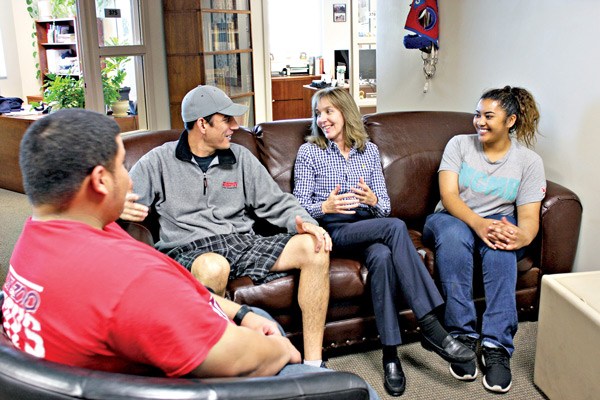UNIVERSITY OF ARIZONA: HORSE RACING
It began as a test program, accepted by the University of Arizona on a five-year trial basis, with the understanding that the industry leaders who requested it also would pay for it.
More than 40 years later, the Race Track Industry Program at the school remains 70 percent self-funded, with a pipeline of almost 700 graduates that includes star horse trainers Bob Baffert and Todd Pletcher, but also a cross-section of executives and racing officials at horse tracks, state racing commissions, horse racing publications, websites and other pari-mutuel facilities.
“Although racing is small if you look at what’s out there all over sports, we still have more requests for interns and more job opportunities than we have graduates going out, which is nice,” said Wendy Davis, a former horse farm owner who graduated from the program and now serves as its associate coordinator. “This is a real industry. And it isn’t what you see in the TV shows.
 |
Santa Anita Park VP Amy Zimmerman (center) chats with RTIP students on a recent visit.
Photo by: RACE TRACK INDUSTRY PROGRAM
|
“Not everybody wears a trench coat and smokes a cigar.”
It was that sentiment that led Frank Vessels Jr., son of the founder of Los Alamitos Race Course and head of the American Quarter Horse Association, to gather horse industry leaders behind the push to develop an educational path into the industry early in the 1970s. Their efforts to convince a large land grant university to house the program fell on deaf ears until Arizona stepped up, under the condition that Vessels line up the initial funding. Backed by contributions from his family, the AQHA and the American Greyhound Association, Vessels delivered enough to launch the program in the animal sciences department of the university’s agriculture school.
As it has from the outset, the RTIP offers two distinct tracks: An equine management path that preps students to work with the breeding and training of animals, and a business path that sets them on their way to careers outside the rails.
While the former is the track chosen by most who aspire to be the next Baffert or Pletcher, or work on the breeding side of the industry, about half pick the business side.
RTIP alumni workplaces
■ Churchill Downs
■ Gulfstream Park
■ Santa Anita Park
■ National Thoroughbred Racing Association
■ New York Racing Association
■ Daily Racing Form
■ Breeders’ Cup Ltd.
All RTIP undergraduate students take two animal-focused classes — introductory horse science and management of the racing animal. They also take two semesters of racing law, a key component of a sport that is heavily regulated. Classes in marketing, management, finance, strategy and human resources all are tailored to the racing business.
“Everybody does take quite a bit of business [courses] because that’s the backbone of everything,” Davis said. “But you’re also going to take some animal science. Even if you’re going to be the director of marketing, you need to have an understanding that we’re centering our business on a live animal and you better understand that.”
Students in the business track layer 21 hours of business courses on top of their specialized classes. Those on the equine science path add on 27 hours of equine science, biology and chemistry.
The majority of students who follow the trainer path have a background in the sport before they hit campus. Baffert grew up riding quarter horses. Pletcher came from a horse family, but his father insisted he get a degree before returning to the stables. “He didn’t say what kind of degree,” Davis chuckled.
For those who aren’t born or raised around the horse business, the program offers a door into an industry that otherwise would be difficult to identify and navigate.
The program’s chief fundraising mechanism comes through the school’s annual four-day Symposium on Racing and Gaming, which typically brings together about 400 executives from across the industry to discuss topics that include simulcasting, marketing, casino gaming, track operations, technology and regulation.
Students not only attend but are able to network, choosing a mentor to join them for a 90-minute lunch.
“People in the industry want our graduates,” Davis said. “We have a second and third generation of graduates now who call back and say, ‘Who do you have? This is what we need.’ I know it can be difficult to break into sports, but there’s no shortage of opportunity here.”
— Bill King




